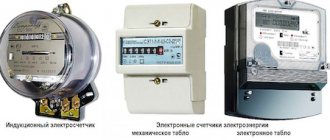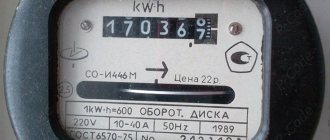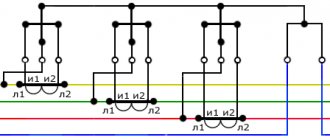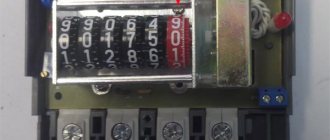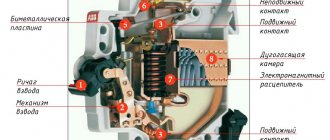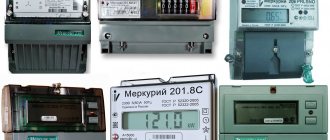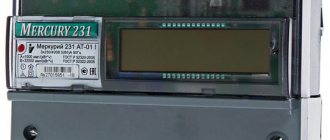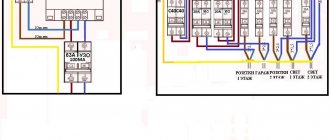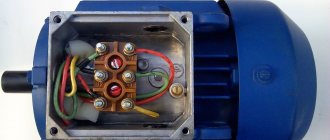The Mercury 230 meter is a three-phase device for determining the consumed electrical energy in 3 or 4 wire circuits at several tariffs. Depending on the design, the device takes into account the active and reactive components of electricity and is suitable for installation at any individual consumption facilities, allowing the possibility of autonomous operation or as part of a centralized automatic control system.
Type of meter – Mercury 230 ART-03
Design and principle of operation
The accounting principle involves recording incoming pulses and then converting them into information processed by an analog-digital module and displayed by a liquid crystal display or mechanical counting device. Depending on the design and configuration, the data is transmitted to a remote computer via a modem and stored in the internal memory of the electricity meter.
The device is made of the following parts:
- composite body;
- an electronic unit, including measuring and fixing devices, a memory board, and a liquid crystal display;
- mechanical counting unit (for AM version);
- contact connection unit, closed with a removable cover.
ENERGY MEASUREMENT
Energy measurement by the meter is carried out digitally with a sampling frequency of 4000 Hz (period 250 μs) for each channel of the measured voltage or current value. The numerical values corresponding to the input voltage in the current and voltage channels are then multiplied, thus giving a value proportional to the instantaneous active power consumption. Based on the measurement results for the network period, reactive power is calculated. Further, the power values obtained in this way are accumulated in intermediate batteries. The numbers contained in them are continuously compared with certain calibration thresholds and, if they are exceeded, the threshold values are subtracted from the contents of the intermediate batteries, which corresponds to the passage of a certain portion of electricity to the consumer. Further, these portions of energy are taken into account in tariff accumulators, which are registers for accounting for consumed electricity. In the case of a multi-tariff operating mode of the counter, there are four such registers.
Specifications
| Characteristics | Magnitude |
| Accuracy class | 1 according to GOST 31819.21-2012; 0.5S according to GOST 31819.22-2012; 1 or 2 according to GOST 31819.23-2012. |
| Rated voltage (Unom), V | 3×230/400 or 3×57.7/100 |
| Set operating voltage range in relation to Unom | 0,9 — 1,1 |
| Extended operating range in relation to Unom | 0,8 — 1,15 |
| Limit operating range in relation to Unom | 0 — 1,15 |
| Base/maximum current for directly connected meters, A | 5(60) or 10(100) |
| Rated/maximum current for meters connected via a transformer, A | 5/7,5 |
| Rated frequency value, Hz | 50 |
| Starting current (sensitivity), mA, no more: | |
| for a meter with Ib=5 A for a meter with Ib=10 A for a meter with In=5 A | 20 40 5 |
| Counter constant, imp./(kW*h): | |
| in telemetry mode in verification mode | 500 or 1000 or 5000 16000 or 32000 or 160000 |
| Accuracy of meter clocks at normal temperature in the on and off state, s/day | ±0,5 |
| Measuring the accuracy of the clock in the on and off state, s/°C/day: | |
| in the temperature range from -10 to +45°C in the remaining operating temperature range | ±0,15 ±0,2 |
| Liquid crystal indicator: | |
| number of displayed digits unit price of the least significant digit when displaying energy, kWh | 8 0,01 |
| Total power consumed by the current circuit, V*A, no more | 0,1 |
| Active power in each meter voltage circuit, W, no more | 2 |
| Total power consumed by each voltage circuit, V*A, no more | 10 |
| External interface supply voltage range, V: | |
| CAN, RS-485 GSM modem | 5,5 — 12,5 7 — 9 |
| External backup voltage range, V | 5,5 — 9 |
| Average current consumption from external power supply of CAN and RS-485 interfaces, mA, no more | 30 |
| Additional current consumption of meters from an external backup power source, mA, no more | 150 |
| Maximum number of valid tariffs | 4 |
| Overall dimensions of the meter, mm, no more: | |
| height width length | 258 170 74 |
| Meter weight, kg, no more | 1,5 |
| Limit operating temperature range, °C | -40… +55 |
| Limit range of storage and transportation, °C | -50… +70 |
| Average time to failure, hours. | 150000 |
| Standard service life, years | 30 |
| Calibration interval, years | 16 |
| Price, increased rub. | from 2000 |
Overall dimensions of the meter - Mercury 230
Connection diagrams
The installation methods for the Mercury 230 AM meter and single-phase devices are largely similar. But there are many differences and difficulties when installing three-phase devices, so they are produced with an installation diagram located on the back of the case.
Correct installation of the meter requires strict adherence to the sequence of connecting wires that differ in the color of the insulating coating. For a three-phase network, phase A can be highlighted in blue or cyan, phase B in orange or brown, phase C in purple, and the neutral or neutral phase in green.
For devices such as Mercury 230AM, 230AR, 230ART, 230 ART2, the following installation methods can be noted:
- by direct connection;
- using 2 or 3 current transformers;
- to a 3-wire network via 2 voltage transformers and 2 current transformers;
- by connecting to a 3 or 4-wire network with 3 voltage and current transformers.
Direct connection of the device implies a direct connection to a network with voltages of 220 and 380 V. The connection diagram of the three-phase Mercury meter provides for the installation of an RCD (residual current device) and an arrester (nonlinear surge limiter).
Indirect connection
This method of connecting the Mercury 230 meter through current transformers facilitates the accounting of energy costs at generators of power stations. Here the transformers are located on the busbars extending from the generator. The terminals transmit information to the meter, which records the amount of electricity produced. Electricity is transmitted through distribution devices and power lines.
Direct connection
The direct connection diagram for the Mercury 230 meter is the simplest and requires only the correct connection of the incoming and outgoing cables to the required terminals of the device. If for phase A terminal No. 1 is the input, terminal No. 2 is the output, then phases B, C and zero are connected in series to sockets numbered 3 to 8.
Semi-indirect inclusion
This option is used for energy consumption facilities with a power of more than 60 kW. Current transformers used for connection according to this circuit have electrical wires instead of primary windings. The device records the voltage that appears when electricity flows through the secondary winding. The Mercury 230 AM meter can be connected using various indirect connection schemes.
The sequence of switching on the electric meter terminals is as follows:
- 1, 2 and 3, respectively, the input, the end of the measuring winding and the output of phase A;
- 4, 5 and 6 - input, end of the measuring winding and output of phase B;
- 7, 8 and 9 - input, end of the measuring winding and output of phase C;
- 10 and 11 - input and output of phase “0”.
Significant simplification of the installation of the device can be achieved by using a semi-indirect connection of the transformer current according to the “star” circuit. Along with this, the number of wires is reduced, the accuracy of current readings is maintained, although the internal connection diagram becomes somewhat more complicated.
Advantages of the device
The advantages of the model are the following qualities:
- reliable constructive protection against data falsification;
- accounting data for several tariffs (depending on the design);
- multifunctional capabilities;
- high accuracy of data recording;
- affordable price;
- a large selection of modifications, with the ability to select the appropriate one depending on the expected operating conditions - the availability of functions for remote information transfer and connection to a centralized control network;
- ease of installation and connection;
- convenience of taking readings;
- Possibility of individual adjustment to the maximum characteristics of the network.
Types of three-phase electricity meters
There are 3 main types of this type of device:
- Indirect connection. This type of meter can be connected to a three-phase network using a transformer.
- Direct connection. In this case, the device is connected directly to the network.
- Semi-indirect inclusion. This method involves connecting using a transformer.
If when installing a single-phase meter only one connection diagram is used, then for installing three-phase devices several different connection methods are used.
Types of counter
The device is produced in two basic versions:
- AR – a model that takes into account the active and reactive components of electricity at several tariffs, equipped with a liquid crystal display;
- AM is a meter with a mechanical reading device that summarizes readings according to a single tariff plan.
The AR version is produced in the following modifications:
- 00 R – transformer connection model with a working (maximum) electric current of 5 (7.5) A and an RS-485 interface;
- 01 R – direct connection device with current characteristics of 5 (60) A;
- 02 R – differs from the previous modification in the magnitude of the electric current – 10 (100) A;
- 03 R – product with an electric current of 5 (7.5) A;
- 01 CL, 02 CL, 03 CL - three similar devices in terms of technical characteristics, but equipped with a CAN interface and a PLC modem.
The AM version is represented by the following modifications:
- 00 – connection requires the use of a transformer, current characteristics are 5 (7.5) A;
- 01 – connects directly, electric current value – 5 (60) A;
- 02 – current parameters differ from the previous model – 5 (100) A;
- 03 – version with current characteristics similar to modification 00.
Performance characteristics – AM
The listed modifications differ in accuracy class and constant value. More details about the technical characteristics and configuration of the manufactured versions are indicated in the passport documentation.
Additional counter features
Based on the modification, the device has additional functions:
- Forward and reverse metering of electricity;
- Energy metering for each phase;
- Saving an archive of received capacities at step-by-step intervals from 1 to 45 minutes. The archive storage time reaches 85 days;
- The maximum value of morning and evening power is recorded;
- Current quality is monitored;
- Losses and magnetic influence are taken into account - an entry is made in the log.
We recommend: Meter SEB-2A: overview of parameters, connection
Taking readings
To make the device with a mechanical roller display for taking readings, it is enough to write down the whole value of the number of kWh, without leading zeros and decimals (the right roller is red). After subtracting past readings and multiplying by the tariff amount, the amount to be paid is determined.
For LCD execution, data is taken and calculated separately for each tariff plan. To do this you need:
Taking readings from the meter - Mercury 230
- Wait for the automatic appearance of the consumption indicator value for tariff 1, indicated on the T1 display, or select it by briefly pressing the enter button.
- Write down the value, without taking into account two (one or there may be no fractional value at all, depending on the design) fractional digits to the right of the point (red frame in the photo).
- Subtract last month's figures and multiply by the price.
- Repeat the operation for each of the tariff plans.
- Sum the values.
You can watch the video for more information about taking readings:
We take readings from a single-tariff meter Mercury 230
In order to record the readings of a single-tariff Mercury meter, look at the 6-digit dial and write down the numbers to the decimal point.
To determine the meter readings for the last month, subtract the readings that were a month ago from the current latest meter readings.
